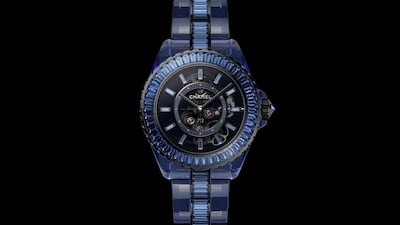“I dreamt of giving a colour to black, of illuminating it with blue,” says Arnaud Chastaingt, director of the Chanel Watch Creation Studio. “I wanted a blue that possesses a rigorous elegance – a blue that is nearly black, or a black that is almost blue.”
To celebrate the 25th anniversary of its bestselling ceramic watch, Chanel unveiled a striking new piece that delivers on Chastaingt’s dream: the J12 Bleu. In a matte shade of midnight, the Bleu is the result of five years of meticulous development – a process that reflects not only Chanel’s obsession with colour, but also its quiet mastery of modern horology.
Blue, of course, is fundamental to Chanel’s visual language – a nod to Gabrielle Chanel’s love of maritime style. Yet, developing a tone that satisfied the house’s exacting standards was no small feat, with Chastaingt describing its discovery as “an epiphany”.

More than half a century after her death, Gabrielle “Coco” Chanel remains fashion’s consummate rule-breaker, having established codes that still feel fresh today. From the little black dress to the tweed suit, she placed comfort alongside elegance. Her two-tone shoes, quilted handbags and ropes of pearls remain cornerstones of style. Even Chanel No 5 – launched in 1921 – still dominates global fragrance sales, a testament to its revolutionary formula.
Chanel’s styles were later distilled and reinterpreted by Karl Lagerfeld, who gave them new life across decades of creative direction. Alongside him, Jacques Helleu – artistic director for Chanel’s jewellery, watches, beauty and fragrance – pushed these same codes into a new realm: timekeeping. In 1987, he unveiled Chanel’s first watch, the Premiere, with a case shaped like the No 5 stopper and a bracelet threaded with leather like the brand’s iconic bags.
A decade later, Helleu began sketching a unisex sports watch – a daring move for a house so focused on women. The result was the J12. Crafted from high-tech ceramic, it was lightweight, scratch-resistant and quietly radical. Launched in 1999 in a sleek black finish, the J12 felt like a new language for Chanel – clean, powerful and androgynous.
Its name came from the J-class racing yachts of the America’s Cup, while its 38 millimetre profile and bold silhouette signalled a shift towards genderless, fashion-forward watchmaking. In 2002, a 41mm chronograph was added, followed by an all-white quartz version in 2003, expanding the range while maintaining its sleek identity.

Then came the innovation. In 2005, Chanel introduced the 41mm Superleggera Chronograph, blending black ceramic and anodised aluminium for a watch that was 20 per cent lighter. In 2008, Chanel collaborated with Audemars Piguet on the H2918, a 42mm model in black ceramic with yellow gold accents. That same year, Chanel released the J12 Noir Intense, set with 724 baguette-cut black ceramic stones in white gold, a feat that took more than 200 hours to complete and was limited to only five pieces.
In 2010, the brand turned to respected independent watchmakers Renaud et Papi for the Retrograde Mysterieuse. At 47mm and made of white gold and ceramic, it included a retrograde display, tourbillon and retractable crown. The following year, Chanel unveiled the Chromatic in titanium ceramic, while 2013 brought the Moonphase model, with its aventurine moon disc and poetic complication.

By 2014, Chanel pushed further into haute horlogerie with the Comeete Flying Tourbillon and the J12 G10, the latter nodding to military watch straps but rendered in titanium and alligator leather. The 20th anniversary in 2020 was marked by the diamond-set J12 X-Ray, which was cut almost entirely from transparent sapphire crystal – even the bracelet was hewn, link by link, from raw sapphire.
The 2023 J12 Eclipse box set added a new layer of conceptual brilliance. Comprising seven watches arranged to mirror the phases of a solar eclipse, the collection played with black and white ceramic in configurations that felt as much like sculpture as watchmaking. Only one set was made – and was quickly snapped up by a private collector.

Now, in 2025, the J12 marks its silver jubilee with the J12 Bleu X-Ray. A study in transparency and light, the watch is hewn from a single block of lab-grown sapphire – a process that takes more than 1,600 hours. It features 196 baguette-cut blue sapphires encircling the bezel and bracelet, with an additional 12 as hour markers. Inside, a floating movement is suspended on clear sapphire bridges, adding a near-mystical quality to its precision engineering.
Of course, none of this would be possible without the technical infrastructure behind the design. In 1993, Chanel acquired G&F Chatelain, a watchmaking facility located in La Chaux-de-Fonds, placing artisanal expertise at the heart of the operation. Strategic investments in brands such as Bell & Ross, Romain Gauthier, F P Journe and MB&F have only deepened that horological credibility.
As Chastaingt puts it, ceramic – once viewed as niche – has become precious. “In the course of 25 years, Chanel has elevated ceramic to the level of a precious material,” he says. “It is an inspiring material that offers a vast creative playing field.”
The new J12 Bleu is both tribute and evolution – a continuation of a legacy and a testament to Chanel’s instinct for defying convention. It’s not only a watch. It’s Chanel’s past, present and future, rendered in sapphire blue.



